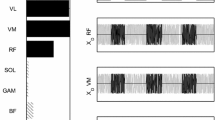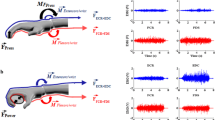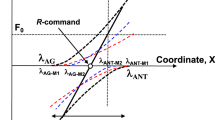Abstract
Electromyographic (EMG) activity was analyzed for the occurrence of synergistic patterns during the steady hold periods of force in the precision grip. To establish the presence of muscle synergies in the amplitude (spatial) domain, the EMG activation levels of pairs of simultaneously active muscles were linearly correlated. Cross-correlations of EMG activity were computed to quantify muscle synergies in the spatiotemporal domain (synchronization). A muscle pair was defined to be synergistically coupled or synchronously activated when the correlation (amplitude domain) or cross-correlation (time domain) was significant for at least two of the three steady state force levels. Muscle synergies in the amplitude domain were found in one-third of the 213 muscle pairs tested, distributed among 47 of the 82 tested muscle combinations. Coactivation was the predominant synergistic pattern, whereas trade-off comprised not more than 23% of the synergies. Cross-correlation peak size varied between 5 and 39% of the autocorrelation size, with delays in the range of ±8 ms and base width between 12 and 20 ms. Synchronization was found in one-fourth of the 213 muscle pairs tested and among 35 of the 82 muscle combinations, i.e., less frequently than covariation of EMG activity levels. However, the interindividual prevalence was higher for synchronization than for synergies in the amplitude domain, since, for the synergistic muscle combinations, almost twice as many muscle pairs were found to be synchronized than coupled in the amplitude domain. Synergies in the two domains occurred independently in some pairs and concurrently in other cases, and were observed between muscles moving the thumb, the index finger, or both digits. Synchronization was more frequent in pairs of muscles supplied by branches of the same peripheral nerve (46%) than in those innervated by different nerves (18%). Synergies in the amplitude domain were distributed in similar proportions across intrinsic, extrinsic, and combinations of both types of muscles, whereas synchronization mainly occurred in pairs of intrinsic muscles. When the task was repeated with slightly lower target forces, there were fewer synergies in the amplitude domain (in 52 of the 213 pairs, distributed among 35 of 82 muscle combinations) and their distribution changed, indicating a flexible, force-dependent mechanism. In conclusion, no strictly coherent interindividual pattern of synergies in the spatial domain could be established.
Similar content being viewed by others
References
Baker JR, Bremner FD, Cole JD, Stephens JA (1988) Short-term synchronization of intrinsic hand muscle motor units in ‘deafferented’ man (abstract). J Physiol (Lond) 396:155P
Bernstein N (1967) The co-ordination and regulation of movements. Pergamon, Oxford
Bouisset S, Lestienne F, Maton B (1977) The stability of synergy in agonists during the execution of a simple voluntary movement. Electroencephalogr Clin Neurophysiol 42:543–551
Bremner FD, Datta AK, Stephens JA (1989) A mechanism for muscle synergy. In: Henatsch HD, Windhorst U, Laouris Y, Meyer-Lohmann I (eds) Perspectives in motor control: brain storming on the state of affairs and future development. AIM Verlag, Göttingen, pp 44–50
Bremner FD, Baker JR, Stephens JA (1991a) Correlation betweeen the discharges of motor units recorded from the same and from different finger muscles in man. J Physiol (Lond) 432:355–380
Bremner FD, Baker JR, Stephens JA (1991b) Variation in the degree of synchronization exhibited by motor units lying in different finger muscles in man. J Physiol (Lond) 432:381–399
Bremner FD, Baker JR, Stephens JA (1991c) Effect of task on the degree of synchronization of intrinsic hand muscle motor units in man. J Neurophysiol 66:2072–2083
Brown JMM, Bronks R (1988) The electromyographical basis of inaccurate motor performance. Eur J Appl Physiol Occup Physiol 58:132–140
Buchanan TS, Rovai GP, Rymer WZ (1989) Strategies for muscle activation during isometric torque generation at the human elbow. J Neurophysiol 62:1201–1212
Buchanan TS, Almdale DPJ, Lewis JL, Rymer WZ (1990) Characteristics of synergic relations during isometric contractions of human elbow muscles. J Neurophysiol 56:1225–1241
Buys EJ, Lemon RN, Mantel GWH, Muir RB (1986) Selective facilitation of different hand muscles by single corticospinal neurones in the conscious monkey. J Physiol (Lond) 381:529–540
Cole KJ, Abbs JH (1986) Coordination of three-joint digit movements for rapid finger-thumb grasp. J Neurophysiol 55:1407–1423
Datta AK, Farmer SF, Stephens JA (1991) Central nervous pathways underlying synchronization of human motor unit firing studied during voluntary contractions. J Physiol (Lond) 432:401–425
Davey NJ, Ellaway PH, Friedland CL (1990) Motor unit discharge characteristics and short term synchrony in paraplegic man. J Neurol Neurosurg Psychiatr 53:764–769
De Luca CJ, Mambrito B (1987) Voluntary control of motor-units in human antagonist-muscles: coactivation and reciprocal activation. J Neurophysiol 58:525–542
De Luca CJ, Roy AM, Erim Z (1993) Synchronization of motor-unit firings in several human muscles. J Neurophysiol 70:2010–2023
Farmer SF, Swash M, Ingram DA, Stephens JA (1993) Changes in motor unit synchronization following central nervous lesions in man. J Physiol (Lond) 463:83–105
Fish J, Soechting JF (1992) Synergistic finger movements in a skilled motor task. Exp Brain Res 91:327–334
Flament D, Fortier PA, Fetz EE (1992) Response patterns and post-spike effects of peripheral afferents in dorsal root ganglia of behaving monkeys. J Neurophysiol 67:875–889
Flanders M, Soechting JF (1990) Arm muscle activation for static forces in three-dimensional space. J Neurophysiol 64:1818–1837
Garnett R, Stephens JA (1981) Changes in the recruitment threshold of motor units produced by cutaneous stimulation in man. J Physiol (Lond) 311:463–473
Hepp-Reymond M-C (1988) Functional organization of motor cortex and its participation in voluntary movements. In: Steklis HD, Erwin J (eds) Comparative primate biology, vol 4. Liss, New York, pp 501–624
Hepp-Reymond M-C, Maier MA (1991) Central and peripheral control of dynamics in finger movements and precision grip. In: Requin J, Stelmach GE (eds) Tutorials in motor neuroscience. Kluwer Academic, Dordrecht, pp 517–527
Howard JD, Hoit JD, Enoka RM, Hasan Z (1986) Relative activation of two human elbow flexors under isometric conditions: a cautionary note concerning flexor equivalence. Exp Brain Res 62:199–202
Hultborn H, Illert M (1991) How is motor behavior reflected in the organization of spinal systems? In: Humphrey DR, Freund H-J (eds) Dahlem Workshop on motor control: concepts and issues. Wiley, Chichester, pp 49–73
Kirkwood PA, Sears TA (1978) The synaptic connexions to intercostal motoneurones as revealed by the average common excitation potential. J Physiol (Lond) 275:103–134
Lee WA (1984) Neuromotor synergies as a basis for coordinated intentional action. J Mot Behav 16:135–170
Lemon RN (1993) Cortical control of the primate hand. The 1992 G. L. Brown Prize lecture. Exp Physiol 78:263–301
Lemon RN, Bennett KMB, Werner W (1991) The cortico-motor substrate for skilled movements of the hand. In: Requin J, Stelmach GE (eds) Tutorials in motor control. Kluwer Academic, Dordrecht, pp 477–495
Macpherson JM (1991) How flexible are muscle synergies? In: Humphrey DR, Freund H-J (eds) Dahlem Workshop on motor control: concepts and issues. Wiley, Chichester, pp 33–47
Maier MA, Hepp-Reymond M-C, Meyer M (1991) Force control in precision grip: existence of synergies? Soc Neurosci Abstr 17:1110
Maier MA, Hepp-Reymond M-C (1995) EMG activation patterns during force production in precision grip. I. Contribution of 15 finger muscles to isometric force. Exp Brain Res 103:108–122
Press WH, Flannery BP, Teukolsky SA, Vetterling WT (1988) Numerical recipes in C. Cambridge University Press, Cambridge, UK
Richmond FJR, Thomson DB, Loeb GE (1992) Electromyographic studies of neck muscles in the intact cat. I. Pattern of recruitment underlying posture and movement during natural behaviors. Exp Brain Res 88:41–58
Schmied A, Ivarsson C, Fetz EE (1993) Short-term synchronization of motor units in human extensor digitorum communis muscle: relation to contractile properties and voluntary control. Exp Brain Res 97:159–172
Sirin AV, Patla AE (1987) Myoelectric changes in the triceps surae muscles under sustained contractions. Eur J Applied Physiol Occup Physiol 56:238–244
Soechting JF, Lacquaniti F (1989) An assessment of the existence of muscle synergies during load perturbations and intentional movements of the human arm. Exp Brain Res 74:535–548
Soechting JF, Flanders M (1991) Deducing central algorithms of arm movement control from kinematics. In: Humphrey DR, Freund H-J (eds) Dahlem Workshop on motor control: concepts and issues. Wiley, Chichester, pp 293–306
Van Zuylen EJ, Gielen CCAM, Denier van der Gon JJ (1988) Coordination and inhomogeneous activation of human arm muscles during isometric torques. J Neurophysiol 60:15–1548
Author information
Authors and Affiliations
Rights and permissions
About this article
Cite this article
Maier, M.A., Hepp-Reymond, MC. EMG activation patterns during force production in precision grip. Exp Brain Res 103, 123–136 (1995). https://doi.org/10.1007/BF00241970
Received:
Accepted:
Issue Date:
DOI: https://doi.org/10.1007/BF00241970




